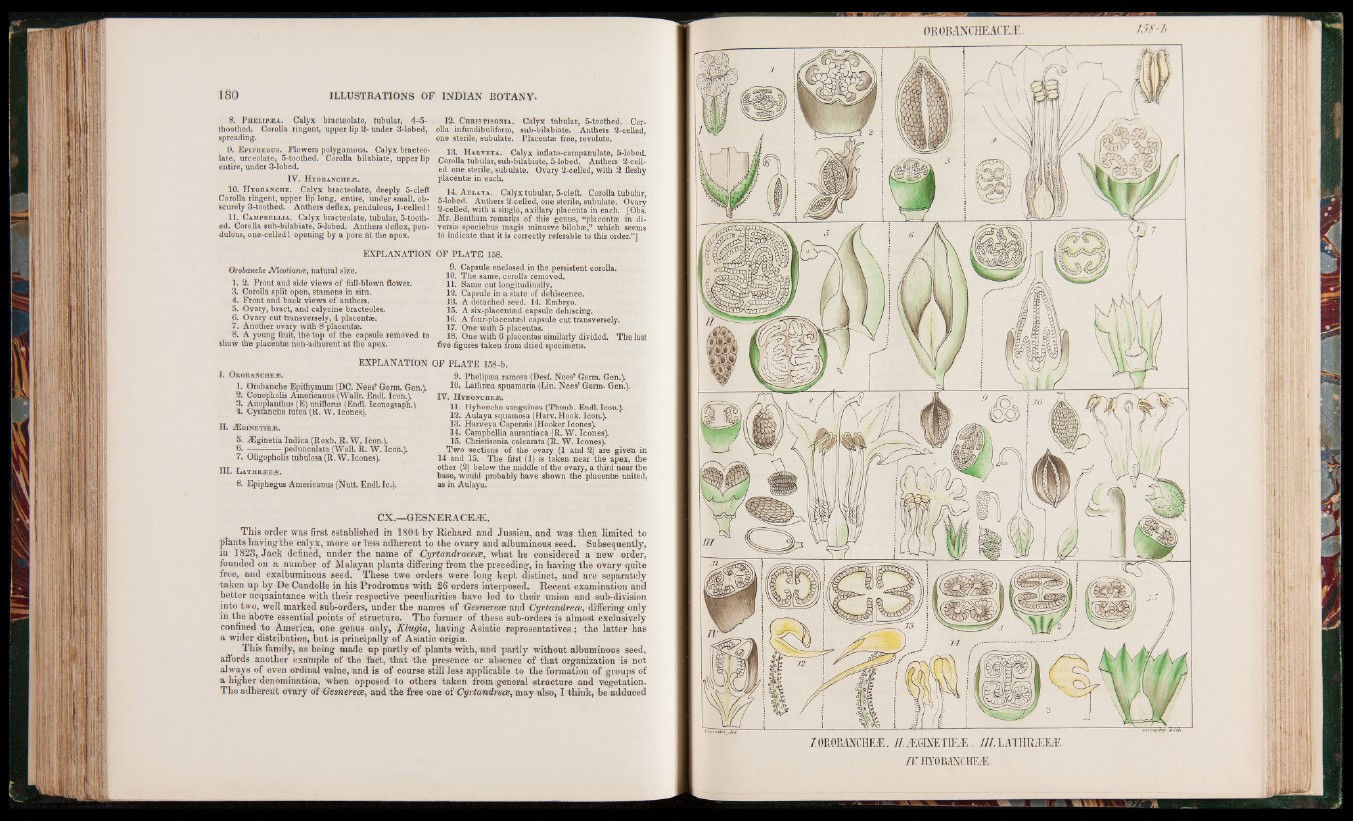
8. Phelipea. Calyx bracteolate, tubular, 4-5-
th oo thed. Corolla ringent, upper lip 2- Under 3-lobed,
spreading.
9. Epiphesus. Flowers polygamous. Calyx bracteolate,
urceolate* 5-toothed. Corolla bilabiate, upper lip
entire, under 3-lob ed.
IV. H yobanchee.
10. H yobanche. Calyx bracteolate, deeply 5-cieft
Corolla ringent, upper lip long, entire, under small, obscurely
3-toothed. Anthers deflex, pendulous, 1-belled!
11. Campbeleia. Calyx bracteolate, tubular, 5-toothed.
Corolla sub-bilabiate^ 5-lobed. Anthers deflex, pendulous,
one-celled! opening by a pore at the apex.
EXPLANATION
Orohanche Nicótiané, natural sizè.
1. 2. Front and sidé views of full-blown flower.
3. Corolla split open, stamens in situ.
4. Front and back views of anthers.
5. Ovary, bract, and calycine bracteoles.
6. Ovary cut transversely, 4 placentae.
7. Another ovary With 8 placentae.
8. A young fruit, the top of the capsule removed to
show the placenta non-adherent at the apex.
EXPLANATION
I . O r o b a n c h e e .
1*. Orobanche Epithymum (DC. Nees’ Germ. Gen.).
2. Cönopholis Americanüs (Wallr. Endl. Icon.).
3. Anoplanthus (E) uni’florus (Endl. Iconograph.)
4. Cystanchë lütea (R. W. leones).
II. uE gi^TIEE.
5. JÉginetia Indica (Roxb. R. W , Icon.).
6- —p * ---pedunculate (Wall. R. W. icon.).
7. Oligopholis tubulosa (R. W. leones).
III. L a th r e e e .
8. Epiphegus Americanus (Nutt Endhlc.).
12* C h r is t iso n ia . Calyx tubular, 5-toothed. Corolla
infundibuliform, sub-bilabiate. Anthers 2-celled,
one sterile, subulate. Placentae free, re volute.
13. Harveya. Calyx inflato-campanulate, 5-lobed.
Corolla tubular, sub-bilabiate, 5-lobed. Anthers 2-celled
one sterile, subulate. Ovary 2-celled, with 2 fleshy
placentae in each.
14. Aueaya. Calyx tubular, 5-cleft. Corolla tubular,
5-lobed. Anthers 2-celled, one sterile, subulate. Ovary
2-celled, with a single, axillary placenta in each. [Obs.
Mr. Bentham remarks of this genus, “placentae in di-
versis speciebus magis minusve bilobae,” which seems
to indicate that it is correctly referable to this order.”]
OF PLATE 158.
9. Capsule enclosed in the persistent corolla.
10. The same, corolla removed.
11. Same cut longitudinally.
12. Capsule in a state of dehiscence.
13* A detached seed. 14. Embryo.
15. A six-placentaed capsule dehiscing.
16. A four-placentaed capsule cut transversely.
17. One with 5 placentas.
18. One with 6 placentas similarly divided. The last
five figures taken from dried specimens.
OF PLATE 158-b.
9. Phelipaea ramosa (Desf. Nees’ Germ. Gen.).
10. Lathraea spuamaria (Lin. Nees’ Germ. Gen.).
IV. H ybonchee.
11. Hybonche sanguinea (Thunb. Endl. Icon.).
12. Aulaya squamosa (Harv.Hook. Icon.).
13. Harveya Capensis (Hooker leones).
14. Campbellia aurantiaca (R. W . leones).
15. Christisonia calcarata (R. W. leones).
Two sections of the ovary (1 and 2) are given in
14 and 15. The first (1) is taken near the apex, the
other (2) below the middle of the ovary, a third near the
base:, would probably have shown the placentae united,
as in Aulaya.
CX.—GÊSNERACEjE .
This order was first established in 1804 by Richard and Jussieu, and was then limited to
plants having the calyx, more or less adherent to the ovary and albuminous seed. Subsequently,
in 1823, Jack defined, under the name of CyrtandYacece, what he considered a new order,
founded on a number of Malayan plants differing from the preceding, in having the ovary quite
free, and exalbuminous seed. Those two orders were long kept distinct, and are separately
taken up by De Candolle in his Prodromus with 26 orders interposed. Recent examination and
better acquaintance with their respective peculiarities have led to their union and sub-division
into two, well marked sub-orders, under the names of Gesnerece and Cyrtandreee, differing only
in the above essential points of structure. The former of these sub-orders is almost exclusively
confined to America, one genus only, Rlugia, having Asiatic -representatives; the latter has
a wider distribution, but is principally of Asiatic origin.
This family, as being made up partly of plants with, and partly without albuminous seed,
affords another example of the fact, that the presence or absence of that organization is not
always of even ordinal value, &nd is of course still less applicable to the formation of groups of
a higher denomination, when opposed to others taken from ;general structure and vegetation.
The adherent ovary oi Gesnefece, and the free one oï Gyrt(mdre&, may -also, I think, be adduced
OROBiNCHEACEiE. J58-b
/ OPvOMNCHEiE. J J .M m E m M . JJL LATHPuEEiE
IV. HYOBANGHExE.